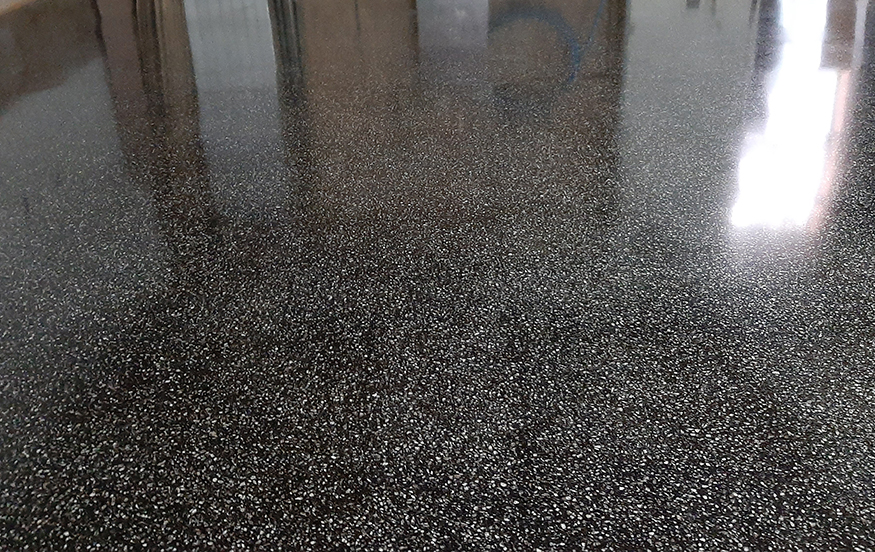Although mastic asphalt is one of the world’s oldest and most traditional construction materials, it can sometimes be wrongly perceived by specifiers and clients as a one-dimensional waterproofing product that is only available in a standard black finish. But like many long-lasting, tried and tested materials, mastic asphalt is being re-imagined, modified and re-examined as a highly relevant building material for today.
Mastic asphalt is an ideal building material for a whole range of construction applications, both new build and refurbishment projects, where a smooth, seamless, durable surface is required. It is commonly associated with roofing, tanking, paving and screeding projects due to its ability to offer total waterproofing protection for decades, but several contractor members of the Mastic Asphalt Council (MAC) have noted an increase in mastic asphalt being specified for flooring projects.
Able to be laid over many different structural bases such as concrete, metal flooring and timber boarding, mastic asphalt offers a dust-free, seamless and user friendly surface, making it ideal for heavy-duty flooring applications, where there are likely to be high levels of traffic from forklift trucks and other vehicles.
The Mastic Asphalt Council has also seen a trend emerging of the use of mastic asphalt flooring incorporating terrazzo. The long and rich history of terrazzo, with archaeologists discovering terrazzo in ancient Neolithic settlements as far back as 8000 years ago, is testament to its status as a construction material that stands the test of time.
Modern interpretations of terrazzo have been created by combining decorative stone chippings with mastic asphalt, which is then polished to create infinite possibilities in any design situation. Some perceive mastic asphalt terrazzo as having a distinctly ‘retro’ look and no two installations are ever the same, as the aggregate is exposed as part of the finishing process. Other finishes can also be created – such as matt or smooth – as opposed to the highly polished effect normally associated with terrazzo. Different visual effects can be created depending on the size and type of aggregate added at the mixing point to create a bespoke finish.
Mastic asphalt terrazzo offers the durability and distinctive features of terrazzo and consists of a traditional mastic asphalt base with a modern finish. Slip and skid resistance can be incorporated into the wearing course of the mastic asphalt.
Bell Asphalt has recently carried out an impressive mastic asphalt terrazzo flooring application at a multi-million pound private residence in London’s Mayfair, located just off Berkeley Square. Mastic asphalt terrazzo was specified for a 120m2refurbishment of the garage floor, due to its exceptional waterproofing properties and decorative terrazzo finish.
The existing floor was uneven so Bell Asphalt levelled the floor with a waterproofing mastic asphalt layer applied at 10-25mm and silver grey terrazzo was incorporated at 30mm, resulting in a highly decorative, hard-wearing finish able to withstand impact and abrasion from vehicles in the garage. Aside from the decorative finish, mastic asphalt terrazzo was specified by architects Nord Studio of Berlin due its exceptional durability, optimum fire rating and non-flammable properties (Classification Bfl – s1 according to EN 13501-1).
As well as being very low maintenance, seamless and easy to clean, mastic asphalt flooring is moisture and rodent resistant, rot proof and a proven radon and methane barrier. Mastic asphalt is also being specified for flooring applications on the basis of its green and recyclable properties.
Mastic asphalt is 100% recyclable at the end of its useful life and it is able to be recycled and broken down into hardcore or used in roof screeds, helping protect the environment as well as buildings for years to come.
Mastic asphalt is carbon neutral and 10 years ago the mastic asphalt sector became the first industry in the world to achieve the CarbonZero standard. It reduces carbon emissions and its seamless nature means it can be easily spot repaired, eliminating the need for costly wholesale replacement.
This article featured within the June edition of Tomorrow’s Contract Floors – click here to take a look.

